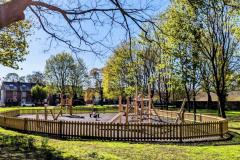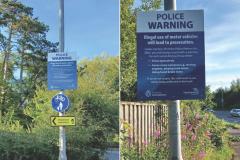A local preservation society has written to George Osborne again outlining their concerns over subsidence at Lindow Moss, which they are certain is caused by the peat extraction, and the lack of protection for water voles.
Following on from a letter they sent in May, Tony Evans, Secretary of Saltersley Common Preservation Society, has written to the Tatton MP again about the ongoing problems at Saltersley Common and further developments which have happened in the meantime.
Tony Evans wrote "A further two kennel blocks at Newgate Kennels are now suffering from subsidence. The kennels are situated at the north eastern boundary near the point where sand has been exposed. This is another breach of condition.
"Close to the south eastern boundary lies the White House. Insurers have appointed loss adjusters who in turn have appointed a company to install and measure the subsidence. If placed on the property market we estimate there would be a value of £700/800,000.00 but the property is now blighted.
"A further two houses are also experiencing subsidence problems and will be joining us in the battle against CEC and Croghan Peat Ltd. In the meantime, our consultant hydrologists ECUS have emailed CEC as they feel they now can prove the causal effect of the peat extraction on the subsidence. This is what the LGO said was needed when she found the council guilty of maladministration on 2012.
"As subsidence appears to happen at all peat extraction sites (Eric Pickles closing the last local site at Chat Moss for similar reasons) we find it strange that CEC insist it's not happening here, especially in light of the evidence. Requests to CEC to say what they think might be causing the subsidence are never answered."
Subsidence at The White House on Rotherwood has been monitored for almost two years now.
Peter Smith whose partner's parents own The White House said "It has shown that the house is sinking on the North west corner.
"We are also having issues with the boiler house. This is sinking and breaking away from the main structure of the house. In spring last year the insurance loss adjusters were so concerned that they sent the builders round to shore up the boiler house (picture above). By June last year the boiler had to be cut off as the gas pipe had been stretched to a dangerous point. The loss adjusters then had to install a flexible gas feed pipe to the boiler.
"As well as the damage to the house we have also suffered several other issues. In 2010 we had to rebuild one of the brick barns. Subsidence had caused the drains move which resulted in large cracks in the building. When we removed the floor, the sub base had sunk leaving a void between the hardcore and the concrete. Over the last few years we have noticed the garden has sunk in several places. In places this has made it difficult to mow some parts of the lawn and has done damage to the lawn mower."
Peter Smith added "The sinking of the land is not confined to the lawn. Some parts of the fields have started to sink. This is most obvious on the fields bordering the peat extraction. The land has dropped leaving some of the mature trees with their roots exposed. These trees are now at danger of falling and one of the mature trees did fall just before Christmas last year. The sinking of this land has left us unable to mow the fields for hay, the main use of these fields in summer. A formal complaint about this situation was made to Cheshire East in mid December."
In the letter to George Osborne, Tony Evans continued "Next, CEC keep insisting that the Water Vole Protection scheme agreed by Croghan Peat and CCC is in place. This a total and blatant lie and we have all the proof needed. You may have read in the newspapers or heard on the news last week about the re-introduction of water voles into Malham Tarn.
"This was carried out by Derek Gow on behalf of the National Trust. Derek has visited us at the moss on two occasions now and on his last visit stated to the local papers 'I have never seen a site so comprehensively trashed'. An invitation to CEC to join Derek on his last visit was declined which is a great pity as we could have worked out where they were getting their information from. Derek is also the author of handbooks on water vole conservation and is considered to be the foremost expert on this subject in the country."
Saltersley Common Preservation Society have invited George Osborne and Mike Suarez, Chief Executive of Cheshire East Council, to visit Lindow Moss and to show them the situation at The White House and the kennels.
George Osborne has confirmed he has raised the matter with the Council and is awaiting a response. Once he receives a full response from them he will provide us with a comment.
Derek Gow, an ecological consultant who specialises in water vole conservation was commissioned by the Saltersley Common Preservation Society to visit Lindow Moss in November 2015, having originally visited the site in 2010 to carry out a water vole survey.
Speaking about the 2010 survey, Tony Evans said "It ran to roughly one hundred pages with text and photographs and concluded that the moss was a mess and the responsibility lay with the council and the operator.
"We gave copies to various officials at Cheshire East Council but would bet that most made their way into the bin. They were totally ignored, as we have been, and the Council insisted, that there wasn't a problem. That is why we commissioned Derek to come and have another look."
Speaking about his findings last year, Derek Gow told wilmslow.co.uk "There has been a change, the habitat has got much worse. Due principally to drainage and overshading from birch scrub.
"Peat extraction is simply devastating. What should be a raised mire with dragonflies, water voles, lizards and birds like nightjars, stonechats, etc is basically just destroyed. Even where tiny patches of habitat remain they are just minute, imperilled by future extraction and too small to host any abundance of natural life.
"I found water voles in a single pool system in the northern corner of the site. In areas where they had been formerly abundant there were no field signs of their presence."
Speaking about his recommendations for the moss, Derek said "An immediate sincere discussion should begin between the site owners and all interested parties with a view to stopping drainage and creating a structured process of habitat restoration. Although it can never be returned to what it was - these habitats are ancient landscape features - much could be accomplished.
"The heather could be restored, scrub cot back, piled logs used to form reptile habitats, more linked pool systems created to provide for water voles and other aquatic life. The area was and should be again a brilliant community resource which people can use and enjoy. These habitats are rare and really with a bit of imagination it could be restored to form an absolutely brilliant community asset."
Additionally, a survey carried out by two Wildlife Trust members in September 2015 concluded that the general wildlife value of this rare raised bog has been largely destroyed by on-going industrial peat mining.
The report stated "While water voles were historically common here, no prime habitat remains. The ditch systems in which water voles previously occurred have lost their value by being allowed to dry out, become overshaded by growth of birch or willow on their banks, had their vegetation stripped out by drainage work, or been obliterated by peat extraction operations
"Excavation work (which in some places has reached the underlying sand sub-strata) has resulted in severe reduction in the water table and dying-out of the site.
"There is no evidence of any work being undertaken to maintain the suitability of the site for water voles, except for the 70 meter long ditch at the northern boundary of the CWT reserve. Although water is artificially held in this ditch, it is unsuitable habitat in other respects, and no water vole field signs have been recorded here in previous reports, nor in the current survey."
Croghan Peat Industries Ltd of Meare, Somerset purchased the Moss in 1997-8. In December 2014 they submitted two planning applications, to build 14 detached houses on part of Lindow Moss and restore the 28 hectares peat extraction site to a natural wetland habitat.
The first application, reference 15/0064M, is for the 28 hectare peat extraction site and the second application,15/0016M, relates to an area of 1.763 hectares to the south of the peat bog.
The owners of the land Andrew Rowland and Richard Bond are proposing that peat extraction ceases once planning permission for the houses is granted and Lindow Moss is restored as a matrix of peatland wetland habitats by encouraging the return of native flora and fauna and enhancing the range of habitats which already exist. The processing area would then be replaced with a development of 14 sustainable family homes.
The two planning applications were expected to be decided in March and April 2015 yet both are yet to be determined.
Planning permission for peat extraction on Lindow Moss was granted by five separate permissions between 1959 and 1967, which expire in February 2042. At present the western part of the peat extraction area must be restored either to a nature conservation after use or an amenity that promotes nature conservation. The eastern section must be restored to agricultural after use by backfilling.
Photos: In the last 6 months ground next to a kennel block has sunk by a further 6” exposing the piles supporting the building. Recently installed cement steps show ground has dropped by a further 2” (the step overlapped the concrete – now a visible gap).












Comments
Here's what readers have had to say so far. Why not add your thoughts below.
Adding more housing on our greenfields only adds to the pressures on our wildlife.
Do CEC really have a practical interest beyond a Local Plan that fuels their salaries and pensions?